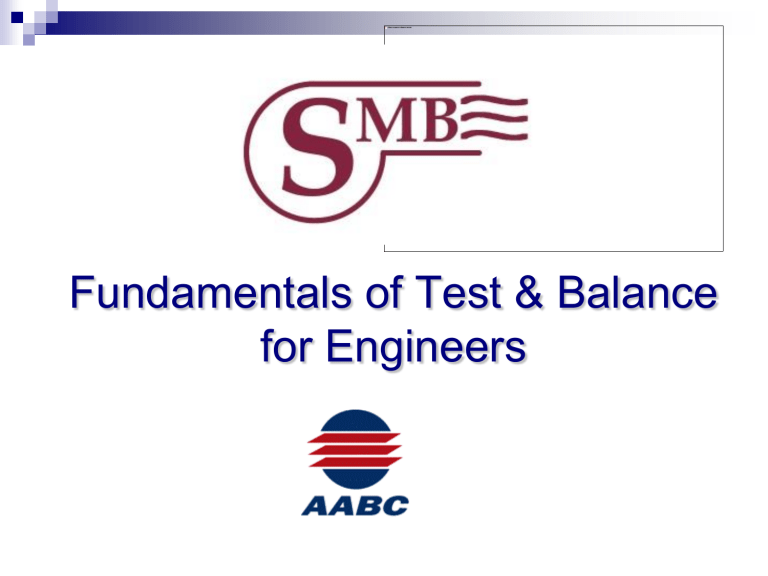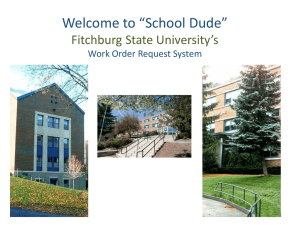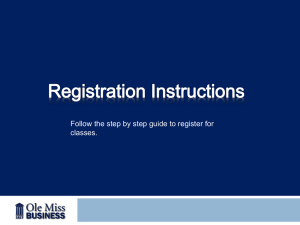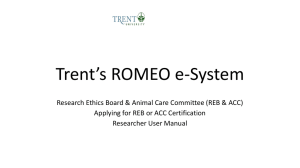to Presentation - AABC Commissioning Group

Fundamentals of Test & Balance for Engineers
Objectives
Help the CxA understand and identify challenges of the
TAB Agency
Explain what can be accurately measured in the field in an HVAC system
Obtain an understanding of the proper use & limitations of TAB instrumentation
Promote a team approach between the CxA and TAB
Agency
Assist in delivering a project to the owner meeting system design intent
Specification Challenges
One of the most beneficial and productive parts of the Cx process is a specification and drawing review.
Utilize common sense; what is the goal or intent?
If the CxA is utilizing the project specifications to establish PFC’s and FPT’s make sure they are applicable. (Who performs their own PFC’s?)
Specification Challenges:
TAB Data
Understand what is meaningful data. Just because the specification calls for a “measurement”, that does not mean it is relevant or useful.
For example; Wet-bulb temperatures
– a single point measurement is not extremely accurate and a steady state load needs to be introduced. Is this data really needed? Will this data provide a benefit to the owner? The coil should be
ARI certified.
Try to think of how data will be obtained and what data will be required before requesting the data:
Will the requested data be accurate , repeatable and meaningful ?
Specification Challenges:
Measurement Tolerances
Avoid ±5% tolerances
Adds cost, but not necessarily value.
May not be feasible, depending on the system and its components.
Reserve tight tolerances for special applications, not comfort cooling/heating. Keep in mind, that in Labs and ORs, the main criteria for airflow is ACH and room pressurization. Typically the room envelope dictates the amount of airflow required to maintain proper pressurization.
The TAB equipment manufacturer’s tolerances sometimes are greater than the specification tolerances.
Specification Challenges:
Marking Damper/Valve Positions
Verify that all balancing damper handles are exposed and visible on externally insulated ductwork. Do these need to be marked? If so, make sure that quadrant style damper handles with standoffs and locking devices are specified and installed so they can be clearly marked.
Marking the external duct insulation is not accurate/helpful.
If valve handles required to be marked, make sure the specified and installed valve has provisions for marking.
Recording the valve position in the TAB report should suffice in most situations.
Specification Challenges:
Marking Damper/Valve Positions
Specification Challenges:
Controls
Make sure that access to the control system is made available to the
TAB agency and CxA. This includes any required hardware and software.
This seems to be a regional issue, not a manufacturer’s issue.
Specification Challenges:
Seasonal Testing
Make sure that the “Seasonal Testing” required is affected by the season.
Utilize the DDC system for trending data.
Typically airflows and water flows are tested at maximum flow conditions and the season does not affect the test data.
Specification Challenges:
Sheaves
Sheave changes are NOT automatically the responsibility of the mechanical contractor or TAB agency.
It is difficult to define who is responsible -- Manufacturer, contractor, engineer? How many are required? At bid time, sheaves are an unknown cost and unknown quantity.
Sheave changes for fans should be included as an allowance in the project or handled as a cost plus change order .
Specification Challenges:
Domestic Water Systems
Is domestic water balancing required?
Most TAB equipment manufacturers prohibit the use of their equipment on potable water systems due to potential contamination and liability.
Consider having temperature sensors installed on the domestic hot water recirculation loop that can report the temperatures to the DDC system .
Plumbing pumps, fire pumps, steam condensate pumps : Typically cannot be accurately tested without a constant, established water flow.
Specification Challenges:
Domestic Water Systems
Specification Challenges:
Duct Air Leakage Testing
Duct leakage testing needs to be coordinated in the specification
Who does the testing? Define responsibilities; providing sheet metal blank offs, providing of test equipment, who signs off, etc.
How many tests are required? Define systems to be tested, etc.
Define the standard and test requirements. Test pressure, etc.
Realize there is a schedule impact
Specification Challenges
Calibration of instruments per manufacturer’s recommendations. (As a note, most require calibration every 2 years.)
Help promote identifying each piece of equipment (fans, AHUs, HPs, VAVs, etc.) with a unique tag .
Never rely on face dampers for air balancing.
Specification Challenges:
Vibration & Sound Testing
If required, make sure the specification is specific about what sound and/or vibration data is required .
Define where readings should be taken and under what test conditions the readings should be obtained.
Airflow Measurement & The Flow Hood
The flow hood is a proportioning device.
The airflow measurement of the flow hood may have to be corrected with a “K” factor.
Airflow Measurement & Fan Curves
Fan curves
AMCA Tested
Produced under laboratory conditions
Free inlet
Straight discharge
Ideal traverse plane
Multiple speeds-extrapolated data
Standard temperature & pressure (STP)
Normal manufacturing tolerances
Know the limitations of fan curves
Airflow Measurement & Fan Curves
ASHRAE Journal Article, November 2005
Airflow Measurement:
Traverse Locations & Alternatives
Ideal traverse plane :
For round duct, AABC, AMCA & ASHRAE all identify the ideal traverse plane as 2 ½ diameters from condition
(discharge, elbow, etc.) for up to 2500 fpm. Add 1 diameter for each additional 100 fpm.
For rectangular duct, E
L
= (4a*b/ π) 0.5 , where “a” & “b” are the duct dimensions.
Airflow Measurement:
Traverse Locations & Alternatives
Example: Alternatives to Traverse:
10,000 cfm, 30” x 20” duct, 2400 fpm
E
L
= (4a*b/ π) 0.5 =27.6”
2 ½ * 27.6” = 69.1”
Face velocity reading of filters, coils, etc.
Summation of airflows at individual outlets
69.1” (~ 6’) straight duct required
Summation of calibrated
VAV boxes as read at the
DDC computer
Airflow Measurement:
Equipment Considerations
Can outdoor air be measured to AHU?
Is there enough ductwork for a proper traverse?
Does unit configuration allow for proper measurement (damper configuration)?
Roof Top Units
Outdoor air measurements are not possible .
Static pressure profile of RTU is not practical unless factory “ports” are installed.
Airflow Measurement:
Airflow Monitoring Stations
The AFMS –
Requires calibration and maintenance
Requires filtered air
Will the AFMS work properly in the installed location?
Is the velocity profile acceptable?
Will the AFMS work at minimum airflow, but function improperly at maximum airflow or vice-versa?
Will the control damper create turbulence and measurement issues?
VAV Systems and Return Air Balancing
Water Flow Measurement:
Pump Curves
Design Requirements :
800 gpm @ 68’
9” Impeller, 20 hp motor,
5BC,1750 rpm (Point 1)
Field Measurements :
Shutoff ΔP = 73’ (Point 2)
Operating ΔP = 70.0’
Results:
Actual: 700 gpm w/9” imp
12.5% below design
Flat Pump Curve – Hard to interpolate.
Utilize measured flows at terminals or branches to determine pump total.
Water Flow Measurement:
Pump Curves
Design Requirements:
800 gpm@ 68’
103/8” Impeller, 20 hp motor,
4E, 1750 rpm
Field Measurements:
Shutoff ΔP = 104’
Operating ΔP = 72’
Results:
Actual: 775 gpm w/103/8” imp
3.1% below design
Steep Pump Curve –
Immediate Resolution.
Pump Flow Measurement
Provide test ports/pump taps at the pumps (Extend outside of insulation).
Provide a flow measuring device at the pump
Fixed orifice type device preferred, use Multi-
Purpose Valves with caution .
Water Flow Measuring Stations:
Sizing
Flow measuring stations need to be sized to allow for a measurable and useful pressure drop.
Too often the flow measuring station is too large and the pressure drop is too low to be useful or accurate.
Several balancing valve manufacturers will have different orifices available so the valve is sized for flow quantity.
The use of Multi-Purpose Valves for total pump flow measurement is typically not accurate
Typically sized line size and not for flow (oversized)
Location is not ideal, need 5 pipe diameters before and after the valve.
Water Flow Measuring Stations:
Strainer Effect
¾” Balancing Valve
50% Open
¾” Balancing Valve
25% Open
Water Flow Measuring Stations:
Strainer Effect
Water Flow Measurement:
Automatic Flow Limiting Devices
These devices do not eliminate water balancing.
Ideal for fan coil units, unit ventilators, heat pumps, VAV reheat coils and areas where access to valves is limited ( actual pressure readings might not be obtained for each autoflow ).
Factory-installed piping kits frequently do not provide access to the ports!!!
Water Flow Measurement:
Factory-Piped Balancing Valves
Water Flow Measurement:
AFLD Installation
Testing a Water System with
Diversity
Repeating water flow measurements in a system with diversity is very difficult. Several considerations are required:
How was the system set up for testing?
What data is required to be reported?
How is the system currently operating?
Testing a Water System with
Diversity
Understand the goals of the TAB Process & FPT’s in a system with diversity
Verify pump performance
Make sure that all coils/elements can provide heating/cooling
Establish the differential pressure operating setpoint
Set up system to operate as efficiently as possible –
Obtain water flow to the coil/element with the most resistance without creating excessive resistance in the system (let the control valve do the work)
Access Challenges
Proper clearance and access must be provided to all dampers, valves, equipment, etc.
Sheetrock ceilings, architectural features, etc.
Locate devices in the corridors outside of OR’s, classrooms, etc.
Access to outlets, dampers, etc. in theatre type seating areas. How will this be accomplished?
AHU is typically not in operation when scaffolding is installed.
Scheduling Challenges
There needs to be enough time allowed in the schedule for the TAB & Cx work to be completed.
All work must be complete for TAB work to commence.
Clean air filters installed.
All strainers cleaned and start-up strainers removed.
All balancing dampers installed and 100% open.
All manual balancing valves and flow measuring stations installed and 100% open.
Temperature Controls complete and functional.
Scheduling Challenges
Phased projects :
Remember that TAB work is completed by system, not by area.
Very seldom does the HVAC system match the “Phasing Areas.”
Make sure that the Owner & Architect understand the possibility that the TAB work might be performed after occupancy.
Variable volume systems (air and water) can have provisions to balance partial HVAC systems. Constant volume systems can pose major complications if they overlap several phases.
Hydronic systems need to be carefully considered for scheduling issues.
TAB Reports
Typically a final TAB report is not available at time of commencement of the Cx FPT’s.
Have an experienced, responsible engineer review the report. It is not just about matching numbers. It is reviewing system performance and employing engineering judgment.
Don’t hesitate to call the TAB agency to review the report together or ask questions.
Keep in mind that there is no benefit to the TAB Agency
( owner’s benefit ) to report problems or deficiencies, it is our responsibility. Be cautious of the “pristine” TAB report.
Questions?
Thank you for your time!
Additional Presentation Topics:
Duct Leakage Testing
Testing Hydronic Systems with Diversity
Water Flow Measurement:
Flow Measuring Stations
Two main types of flow measuring stations:
Fixed orifice or venturi type.
Variable orifice.
Water Flow Measuring Stations:
Fixed Orifice
<>
Water Flow Measuring Stations:
Variable Orifice









